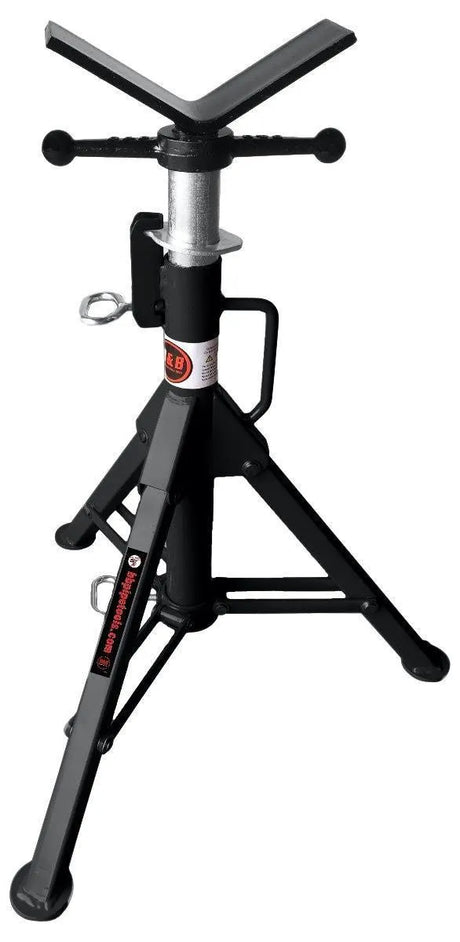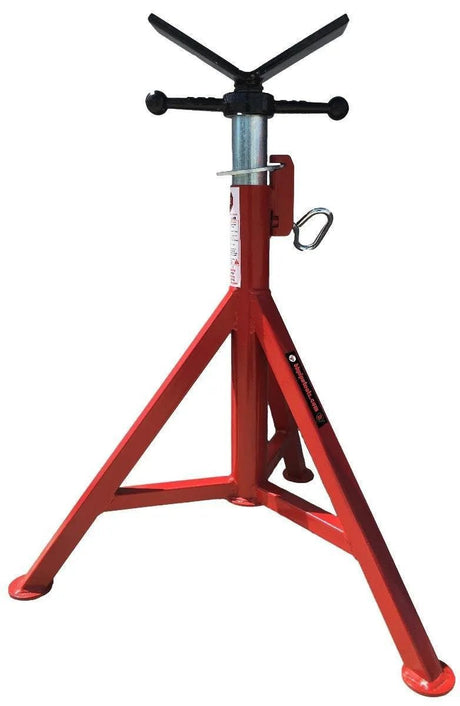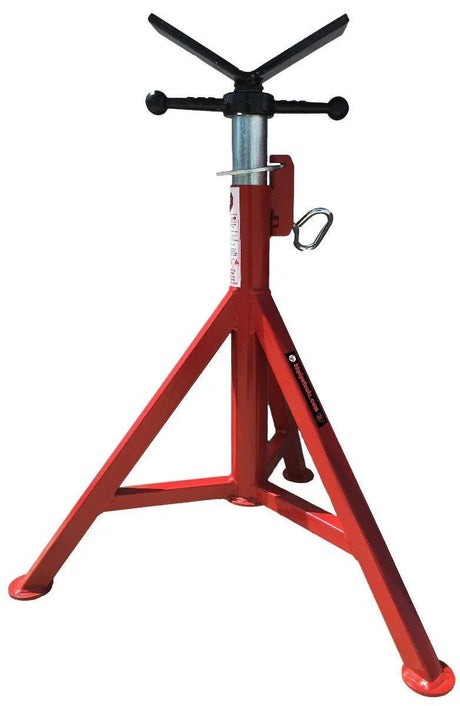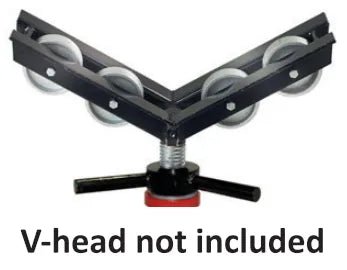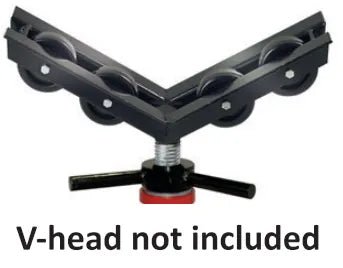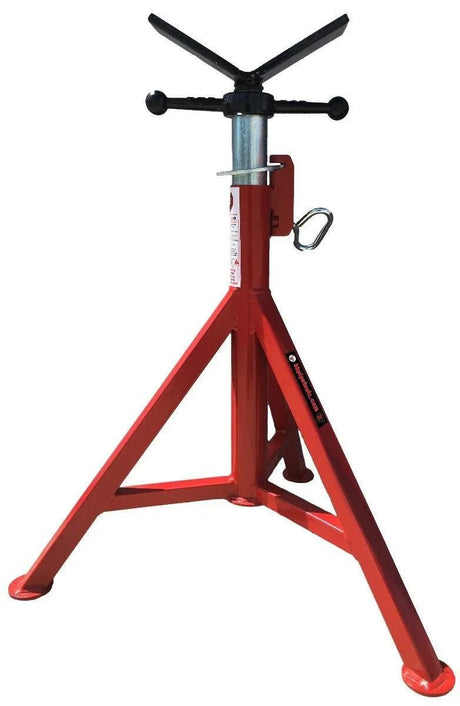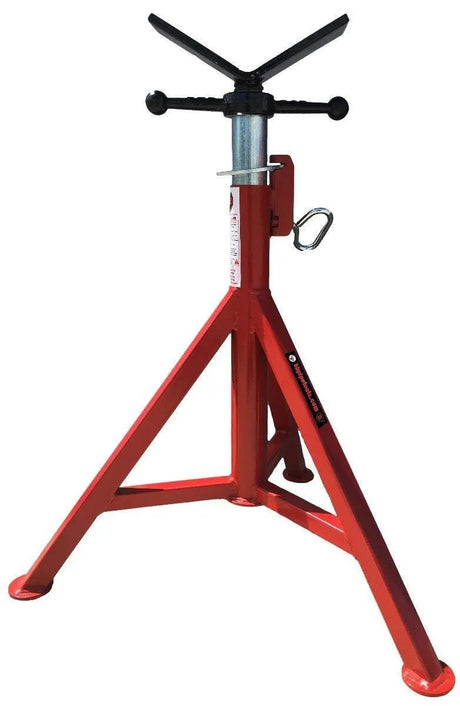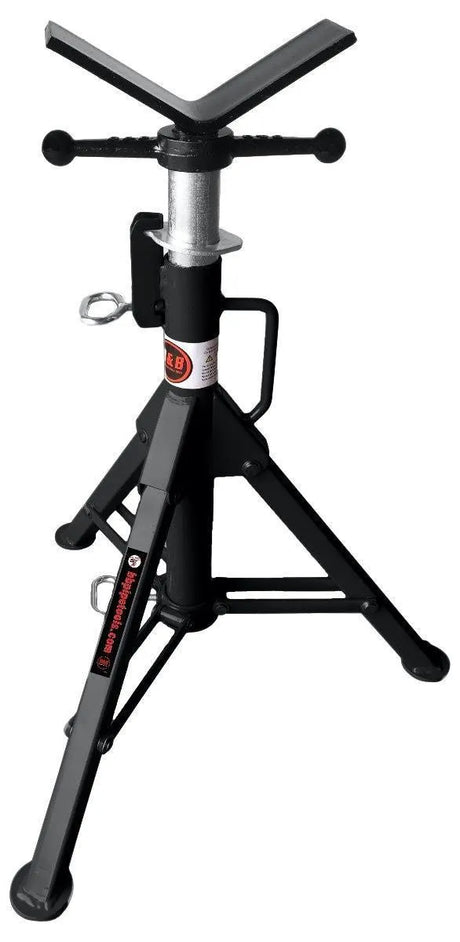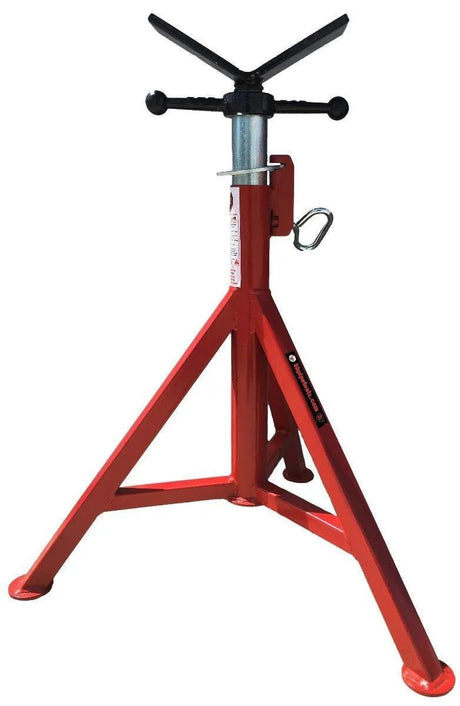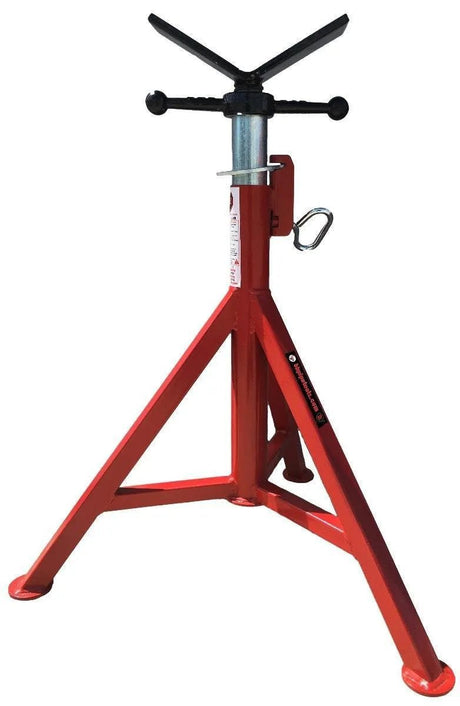Pipe jacks are specialized tools designed to support and hold pipes securely in place during various industrial and construction applications. These tools are essential for ensuring stability and ease of manipulation when working with pipes. Commonly used in pipe fabrication, welding, and installation processes, pipe jacks come in various types to suit different needs.
Uno Pipe Jack - made to order. Up to 20" tall, specify low height. - 4255
$136.13Unit price /UnavailableMathey Dearman B&B Giant Jacks - Steel Wheel Kit (4 Wheels) with Nuts and Bolts - 3502
$140.00Unit price /UnavailableUno Pipe Jack - made to order. Over 20" tall, specify low height. - 4260
$156.32Unit price /UnavailableMathey Dearman B&B Giant Jacks - Rubber Wheel Kit (4 Wheels) with Nuts and Bolts - 3503
$160.00Unit price /UnavailableMathey Dearman B&B Jacks Low Profile Roller Head w/Steel Wheels 22"-39" - 4005
$170.00Unit price /UnavailableMathey Dearman Super Duty Gusseted V w/Solid Acme Rod 16"-26" - 4241
$185.00Unit price /UnavailableMathey Dearman B&B Giant Jacks - Hold Down Chain for PN 3500 - 3506
$195.00Unit price /UnavailableUno Pipe Jack - Single Shorty Jack - over 20" height w/roller head - 4260RL
$199.31Unit price /UnavailableMathey Dearman B&B Giant Jacks - Stainless Steel Sleeves (Set of 2) - 3507
$225.00Unit price /UnavailableMathey Dearman Roller Head w/ Stainless Steel Wheels 32"-48" - 3935
$240.00Unit price /UnavailableMathey Dearman B&B Giant Jacks - Stainless Steel Wheel Kit (4 Wheels) with Nuts and Bolts - 3508
$280.00Unit price /UnavailableMathey Dearman B&B Giant Jacks - Giant Jack Head Only (No Wheels) - 1 3/4" Rod - 30056
$295.00Unit price /UnavailableMathey Dearman B&B Fixed Four Leg Pipe Roller - Hi Profile 32" - 4300
$320.00Unit price /UnavailableMathey Dearman B&B Giant Jacks - Three Leg Giant Jack (No Wheels) 33" - 44" - 3501
$330.00Unit price /UnavailableMathey Dearman B&B Giant Jacks - Stainless Steel Wheel Kit (4 Wheels) with Nuts and Bolts - 3508
$350.00Unit price /UnavailableMathey Dearman B&B Fixed Four Leg Pipe Roller - Hi Profile 32" - 4310
$355.00Unit price /Unavailable- $390.00Unit price /Unavailable
Mathey B&B Adjustable Roller Head Pipe Stand w/ Stainless Steel Wheels - 4315
$400.00Unit price /UnavailableMathey Dearman 3604 B&B Four Leg V-Head Mega Jack 5,000 lbs. capacity 31" - 49" / 787.4mm - 1244.6mm
$410.00Unit price /UnavailableMathey Dearman B&B Giant Jacks - Giant 3 Package with Jack and Steel Wheels - 3512
$470.00Unit price /UnavailableMathey Dearman B&B Giant Jacks - Urethane Swivel Caster Kit (5 Casters) for PN 3500 - 3504
$480.00Unit price /UnavailableMathey Dearman B&B Giant Jacks - Giant 3 Package with Jack and Rubber Wheels - 3513
$490.00Unit price /UnavailableMathey B&B Height Adjustable Four Leg Pipe Roller w/ Steel Wheels - 4375
$590.00Unit price /UnavailableMathey B&B Height Adjustable Four Leg Pipe Roller w/ Rubber Wheels - 4380
$605.00Unit price /UnavailableMathey B&B Five Leg Giant Jack (No Wheels or Casters) 25" - 36" - 3500
$645.00Unit price /Unavailable
Welding Pipe Stand & Jacks: A Guide to Pipe Jacks and Stands
What are Pipe Jacks?
Pipe jacks are specialized tools designed to support and hold pipes securely in place during various industrial and construction applications. These tools are essential for ensuring stability and ease of manipulation when working with pipes. Commonly used in pipe fabrication, welding, and installation processes, pipe jacks come in various types to suit different needs. For instance, V-head pipe jacks feature a V-shaped head that cradles the pipe, providing a secure hold. Adjustable pipe jacks, on the other hand, can accommodate pipes of various sizes, making them versatile for different projects. With their robust design, pipe jacks make it easy to position and work on pipes efficiently.
Key Features and Accessories
When selecting a pipe jack, it’s crucial to consider the key features and accessories that will best meet your specific needs. High-quality materials and construction are paramount for ensuring durability and strength. Adjustable height and width are also important, allowing the pipe jack to accommodate different pipe sizes. Specialized heads, such as V-heads, provide a secure hold on the pipe, enhancing stability during use. Additionally, it’s essential to choose a pipe jack with a rated capacity that ensures safe and reliable operation. Third-party tested products can further guarantee the safety and performance of the product.
Some pipe jacks come with useful accessories that enhance their functionality. Pipe stands and rollers can provide additional support and stability, while different head options allow for versatility in handling various pipe sizes and types. Adjustable legs are beneficial for working on uneven surfaces, and storage cases offer convenient transportation and storage solutions. By considering these features and accessories, you can select a pipe jack that will efficiently meet your project requirements.
Load Capacity and Stability
When it comes to pipe jacks and stands, load capacity and stability are crucial factors to consider. A pipe jack stand with a high load capacity can support heavier pipes, making it ideal for heavy-duty applications. Look for a pipe jack stand with a load capacity that meets your specific needs, and ensure that it is rated for the type of pipe you will be working with.
Stability is also essential, as a pipe jack stand that is not stable can tip over or collapse, causing damage to the pipe and potentially injuring someone. Look for a pipe jack stand with a wide base and a low center of gravity to ensure stability. By prioritizing load capacity and stability, you can ensure safe and efficient operation in your projects.
Adjustability and Durability
Adjustability is another important feature to consider when selecting a pipe jack stand. A pipe jack stand that is adjustable can accommodate pipes of different sizes, making it a versatile tool for various applications. Look for a pipe jack stand with adjustable legs or an adjustable head to ensure that it can accommodate different pipe sizes.
Durability is also a critical factor to consider, as a pipe jack stand that is not durable can break or wear out quickly, requiring frequent replacement. Look for a pipe jack stand made from high-quality materials, such as steel or aluminum, and ensure that it is built to withstand heavy use. Investing in a durable product will save you time and money in the long run, providing reliable performance for years to come.
Choosing the Right Pipe Jack Stand
Selecting the right pipe jack stand can be a daunting task given the numerous options available in the market. To make an informed decision, consider the following factors:
-
Pipe Size and Type: Ensure the pipe jack stand is compatible with the specific pipe size and type you are working with.
-
Rated Capacity: Choose a pipe jack stand with a rated capacity that exceeds the weight of the pipe to ensure safe operation.
-
Adjustability: Opt for a pipe jack stand with adjustable height and width to accommodate different pipe sizes, providing versatility for various projects.
-
Durability: Look for a pipe jack stand made from high-quality materials and robust construction to ensure long-lasting performance.
-
Brand Reputation: Select a reputable manufacturer with a proven track record of producing high-quality pipe jacks and stands. This ensures reliability and quality in your tools.
-
Choose a brand that offers more head options than any other manufacturer, ensuring a wide range of capabilities and superior performance.
-
By considering these factors, you can choose a pipe jack stand that will provide the support and stability needed for your pipe-related tasks.
Types of Pipe Jacks and Stands
There are several types of pipe jacks and stands available, each with its own unique features and benefits. Some common types of pipe jacks and stands include:
-
V-head pipe jacks: These pipe jacks have a V-shaped head that allows for easy positioning and securing of pipes. The V-head design cradles the pipe, providing a stable and secure hold.
-
Pipe stands: These stands are designed to support pipes at a specific height, making it easy to work on them. They are ideal for tasks that require the pipe to be held in a fixed position.
-
Jack stands: These stands are designed to support heavy loads, making them ideal for heavy-duty applications. They provide robust support for large and heavy pipes.
-
Adjustable pipe jacks: These pipe jacks have adjustable legs or heads, making them versatile tools for various applications. They can accommodate different pipe sizes and are suitable for a wide range of projects.
By understanding the different types of pipe jacks and stands, you can choose the right tool for your specific needs, ensuring efficient and effective operation.
Safety Considerations
When working with pipe jacks and stands, safety is a top priority. Here are some safety considerations to keep in mind:
-
Always follow the manufacturer’s instructions for use and maintenance.
-
Ensure that the pipe jack stand is rated for the type of pipe you are working with.
-
Always use a pipe jack stand on a level surface to ensure stability.
-
Never overload a pipe jack stand, as this can cause it to tip over or collapse.
-
Always inspect the pipe jack stand regularly for damage or wear.
By adhering to these safety guidelines, you can prevent accidents and ensure a safe working environment.
Maintenance and Care
To ensure that your pipe jack stand lasts for a long time, regular maintenance and care are essential. Here are some tips for maintaining and caring for your pipe jack stand:
-
Regularly inspect the pipe jack stand for damage or wear. Address any issues promptly to prevent further damage.
-
Clean the pipe jack stand regularly to prevent rust and corrosion. Use appropriate cleaning agents and methods to keep the stand in good condition.
-
Lubricate the moving parts of the pipe jack stand to ensure smooth operation. Regular lubrication will prevent wear and tear on the components.
-
Store the pipe jack stand in a dry, secure location when not in use. Proper storage will protect the stand from environmental damage.
-
Follow the manufacturer’s instructions for maintenance and repair. Adhering to these guidelines will ensure the longevity and reliability of your pipe jack stand.
By following these maintenance and care tips, you can keep your pipe jack stand in optimal condition, ensuring reliable performance for all your projects.
Pipe Jacks, Stands, and Supports
Pipe jacks, stands, and supports are indispensable tools for any pipe fabrication, welding, or installation project. They provide a stable and secure hold on pipes, allowing for easy manipulation and positioning. When selecting these tools, consider the following:
-
Reputable Manufacturers: Sumner and B&B are well-known manufacturers that offer a wide range of high-quality pipe jacks and stands.
-
Availability: Look for products that are in stock and easy to order online or through a cart system, ensuring you can get the tools you need without delay.
-
Ease of Use: Choose products with user-friendly designs and high-quality materials for efficient and effective operation.
-
Rated Capacity and Testing: Ensure the products have a rated capacity suitable for your needs and have undergone third-party testing for safety and reliability.
-
Adjustability: Opt for products with adjustable features to accommodate different pipe sizes and types, providing versatility for various projects.
These stands are often considered the strongest in the market, providing unmatched durability and safety for heavy-duty applications.
By considering these factors, you can select the right pipe jacks, stands, and supports for your specific needs, ensuring a successful and efficient project.
Welding Pipe Stand & Jacks: A Guide to Pipe Jacks and Stands
What are Pipe Jacks?
Pipe jacks are specialized tools designed to support and hold pipes securely in place during various industrial and construction applications. These tools are essential for ensuring stability and ease of manipulation when working with pipes. Commonly used in pipe fabrication, welding, and installation processes, pipe jacks come in various types to suit different needs. For instance, V-head pipe jacks feature a V-shaped head that cradles the pipe, providing a secure hold. Adjustable pipe jacks, on the other hand, can accommodate pipes of various sizes, making them versatile for different projects. With their robust design, pipe jacks make it easy to position and work on pipes efficiently.
Key Features and Accessories
When selecting a pipe jack, it’s crucial to consider the key features and accessories that will best meet your specific needs. High-quality materials and construction are paramount for ensuring durability and strength. Adjustable height and width are also important, allowing the pipe jack to accommodate different pipe sizes. Specialized heads, such as V-heads, provide a secure hold on the pipe, enhancing stability during use. Additionally, it’s essential to choose a pipe jack with a rated capacity that ensures safe and reliable operation. Third-party tested products can further guarantee the safety and performance of the product.
Some pipe jacks come with useful accessories that enhance their functionality. Pipe stands and rollers can provide additional support and stability, while different head options allow for versatility in handling various pipe sizes and types. Adjustable legs are beneficial for working on uneven surfaces, and storage cases offer convenient transportation and storage solutions. By considering these features and accessories, you can select a pipe jack that will efficiently meet your project requirements.
Load Capacity and Stability
When it comes to pipe jacks and stands, load capacity and stability are crucial factors to consider. A pipe jack stand with a high load capacity can support heavier pipes, making it ideal for heavy-duty applications. Look for a pipe jack stand with a load capacity that meets your specific needs, and ensure that it is rated for the type of pipe you will be working with.
Stability is also essential, as a pipe jack stand that is not stable can tip over or collapse, causing damage to the pipe and potentially injuring someone. Look for a pipe jack stand with a wide base and a low center of gravity to ensure stability. By prioritizing load capacity and stability, you can ensure safe and efficient operation in your projects.
Adjustability and Durability
Adjustability is another important feature to consider when selecting a pipe jack stand. A pipe jack stand that is adjustable can accommodate pipes of different sizes, making it a versatile tool for various applications. Look for a pipe jack stand with adjustable legs or an adjustable head to ensure that it can accommodate different pipe sizes.
Durability is also a critical factor to consider, as a pipe jack stand that is not durable can break or wear out quickly, requiring frequent replacement. Look for a pipe jack stand made from high-quality materials, such as steel or aluminum, and ensure that it is built to withstand heavy use. Investing in a durable product will save you time and money in the long run, providing reliable performance for years to come.
Choosing the Right Pipe Jack Stand
Selecting the right pipe jack stand can be a daunting task given the numerous options available in the market. To make an informed decision, consider the following factors:
-
Pipe Size and Type: Ensure the pipe jack stand is compatible with the specific pipe size and type you are working with.
-
Rated Capacity: Choose a pipe jack stand with a rated capacity that exceeds the weight of the pipe to ensure safe operation.
-
Adjustability: Opt for a pipe jack stand with adjustable height and width to accommodate different pipe sizes, providing versatility for various projects.
-
Durability: Look for a pipe jack stand made from high-quality materials and robust construction to ensure long-lasting performance.
-
Brand Reputation: Select a reputable manufacturer with a proven track record of producing high-quality pipe jacks and stands. This ensures reliability and quality in your tools.
-
Choose a brand that offers more head options than any other manufacturer, ensuring a wide range of capabilities and superior performance.
-
By considering these factors, you can choose a pipe jack stand that will provide the support and stability needed for your pipe-related tasks.
Types of Pipe Jacks and Stands
There are several types of pipe jacks and stands available, each with its own unique features and benefits. Some common types of pipe jacks and stands include:
-
V-head pipe jacks: These pipe jacks have a V-shaped head that allows for easy positioning and securing of pipes. The V-head design cradles the pipe, providing a stable and secure hold.
-
Pipe stands: These stands are designed to support pipes at a specific height, making it easy to work on them. They are ideal for tasks that require the pipe to be held in a fixed position.
-
Jack stands: These stands are designed to support heavy loads, making them ideal for heavy-duty applications. They provide robust support for large and heavy pipes.
-
Adjustable pipe jacks: These pipe jacks have adjustable legs or heads, making them versatile tools for various applications. They can accommodate different pipe sizes and are suitable for a wide range of projects.
By understanding the different types of pipe jacks and stands, you can choose the right tool for your specific needs, ensuring efficient and effective operation.
Safety Considerations
When working with pipe jacks and stands, safety is a top priority. Here are some safety considerations to keep in mind:
-
Always follow the manufacturer’s instructions for use and maintenance.
-
Ensure that the pipe jack stand is rated for the type of pipe you are working with.
-
Always use a pipe jack stand on a level surface to ensure stability.
-
Never overload a pipe jack stand, as this can cause it to tip over or collapse.
-
Always inspect the pipe jack stand regularly for damage or wear.
By adhering to these safety guidelines, you can prevent accidents and ensure a safe working environment.
Maintenance and Care
To ensure that your pipe jack stand lasts for a long time, regular maintenance and care are essential. Here are some tips for maintaining and caring for your pipe jack stand:
-
Regularly inspect the pipe jack stand for damage or wear. Address any issues promptly to prevent further damage.
-
Clean the pipe jack stand regularly to prevent rust and corrosion. Use appropriate cleaning agents and methods to keep the stand in good condition.
-
Lubricate the moving parts of the pipe jack stand to ensure smooth operation. Regular lubrication will prevent wear and tear on the components.
-
Store the pipe jack stand in a dry, secure location when not in use. Proper storage will protect the stand from environmental damage.
-
Follow the manufacturer’s instructions for maintenance and repair. Adhering to these guidelines will ensure the longevity and reliability of your pipe jack stand.
By following these maintenance and care tips, you can keep your pipe jack stand in optimal condition, ensuring reliable performance for all your projects.
Pipe Jacks, Stands, and Supports
Pipe jacks, stands, and supports are indispensable tools for any pipe fabrication, welding, or installation project. They provide a stable and secure hold on pipes, allowing for easy manipulation and positioning. When selecting these tools, consider the following:
-
Reputable Manufacturers: Sumner and B&B are well-known manufacturers that offer a wide range of high-quality pipe jacks and stands.
-
Availability: Look for products that are in stock and easy to order online or through a cart system, ensuring you can get the tools you need without delay.
-
Ease of Use: Choose products with user-friendly designs and high-quality materials for efficient and effective operation.
-
Rated Capacity and Testing: Ensure the products have a rated capacity suitable for your needs and have undergone third-party testing for safety and reliability.
-
Adjustability: Opt for products with adjustable features to accommodate different pipe sizes and types, providing versatility for various projects.
These stands are often considered the strongest in the market, providing unmatched durability and safety for heavy-duty applications.
By considering these factors, you can select the right pipe jacks, stands, and supports for your specific needs, ensuring a successful and efficient project.

